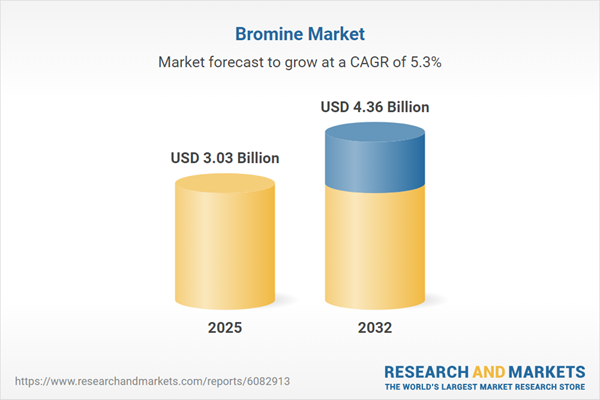Speak directly to the analyst to clarify any post sales queries you may have.
The bromine market is rapidly adapting to regulatory, technological, and geopolitical pressures, positioning industry stakeholders at the forefront of key strategic and operational shifts. Senior decision-makers require a detailed understanding of this evolving landscape to maintain competitive advantages and align business objectives with market demands.
Market Snapshot: Bromine Market Growth Trajectory
The Bromine Market grew from USD 2.88 billion in 2024 to USD 3.03 billion in 2025. It is expected to continue growing at a CAGR of 5.32%, reaching USD 4.36 billion by 2032. Recent expansion is fueled by its critical use in applications spanning flame retardants, agriculture, water treatment, oil and gas, electronics, and pharmaceuticals. New regulatory frameworks and global supply dynamics are reshaping sourcing strategies and impacting downstream value creation, leaving senior B2B leaders to focus on technology investments, partnership models, and alignment with sustainability mandates.
Scope & Segmentation
- Application: Agrochemicals (Ethylene Dibromide, Methyl Bromide), Corrosion Inhibitors, Drilling Fluids (oil-, synthetic-, water-based), Dyes and Pigments, Flame Retardants (Decabromodiphenyl Ether, Hexabromocyclododecane, Tetrabromobisphenol A), Oil & Gas Chemicals (Enhanced Oil Recovery, Hydraulic Fracturing, Well Stimulation), Pharmaceuticals (Anticonvulsants, Brominated Drugs, Sedatives and Hypnotics), Water Treatment (Bromination, Disinfection Biocides).
- End Use: Agriculture (Crop Protection, Post-Harvest Application), Chemical Manufacturing (Brominated Intermediates, Brominated Polymers), Construction, Electronics (Photographic Chemicals, Semiconductors), Oil & Gas (Downstream, Midstream, Upstream), Pharmaceutical (Human Medicine, Veterinary Medicine), Water Treatment (Drinking, Industrial, Wastewater).
- Product Type: Elemental Bromine, Inorganic Bromides (Potassium Bromide, Sodium Bromide), Organobromine Compounds (Brominated Flame Retardants, Pesticides, Pharmaceuticals).
- Purity Grade: High Purity, Pharma, Technical, USP Grade.
- Form: Liquid, Solid (Granules, Pellets, Powder), Solution (Aqueous, Organic Solvent).
- Distribution Channel: Direct Sales (Long-Term Agreements, OEM Contracts), Distributor Sales (National, Regional), E-Commerce (Manufacturer Websites, Online Marketplaces).
- Regions: Americas (North America: United States, Canada, Mexico; Latin America: Brazil, Argentina, Chile, Colombia, Peru), Europe, Middle East & Africa (Europe: United Kingdom, Germany, France, Russia, Italy, Spain, Netherlands, Sweden, Poland, Switzerland; Middle East: United Arab Emirates, Saudi Arabia, Qatar, Turkey, Israel; Africa: South Africa, Nigeria, Egypt, Kenya), Asia-Pacific (China, India, Japan, Australia, South Korea, Indonesia, Thailand, Malaysia, Singapore, Taiwan).
- Key Companies: Albemarle Corporation, Israel Chemicals Ltd, LANXESS AG, Tosoh Corporation, Ascensus Specialties LLC, Ise Chemicals Corporation, The Dow Chemical Company, Chongqing Salt Industry Group Co., Ltd, Zhejiang Yuhong-Chem Group Co., Ltd, Gujarat Boron & Chemicals Ltd.
Key Takeaways for Stakeholders
- Technological development in membrane separation, electrolysis, and digital process controls is elevating bromine extraction efficiency and plant performance.
- Environmental and safety regulations are prompting the shift to eco-friendly flame retardants and reformulated products, impacting raw material choice and value chains across end uses.
- Bromine’s broad application range—in agrochemicals, oil and gas, water treatment, and electronics—requires suppliers and users to tailor their portfolio strategies by region and sector.
- Sustainability and closed-loop processing, involving brine recycling and “green” bromination, are beginning to differentiate market leaders through customer trust and operational resilience.
- Investment in advanced supply chain transparency and collaborative risk management models is enabling responsive adaptation to global sourcing challenges and regulatory actions.
Assessing Tariff Impact on Competitive Positioning
The 2025 introduction of higher U.S. tariffs on imported bromine and derivatives has significantly impacted supply chain cost structures. Domestic producers benefit through stronger strategic positioning, while imported material faces revised contract terms and margin pressures. Adaptation strategies include longer-term supply agreements, direct investments in U.S. extraction operations, and collaborative risk-sharing contracts. Multinational players increasingly shift toward regional diversification, duty-exempt production, and innovation in differentiated derivatives to reduce tariff exposure and maintain market growth.
Methodology & Data Sources
This report is underpinned by meticulous secondary research and in-depth primary interviews with industry practitioners. Analysis integrates data triangulation, scenario planning, and peer-reviewed validation. Key sources include regulatory filings, technical journals, financial disclosures, and direct insights from extraction managers, formulators, and market strategists.
Why This Report Matters
- Guides resource allocation and risk management decisions by providing actionable insights into market drivers, application trends, and regulatory shifts.
- Equips leadership with a comprehensive overview of regional demand patterns, technological innovations, and evolving supply chain dynamics in the bromine segment.
- Supports strategic planning to optimize growth opportunities in target segments and adapt to global market volatility.
Conclusion
The bromine market’s future will be shaped by innovation in extraction, sustainability initiatives, and effective response to global regulatory and supply chain changes. This report delivers clear pathways for senior decision-makers to optimize competitive positioning and sustain long-term value.
Table of Contents
3. Executive Summary
4. Market Overview
7. Cumulative Impact of Artificial Intelligence 2025
Companies Mentioned
The companies profiled in this Bromine market report include:- Albemarle Corporation
- Israel Chemicals Ltd
- LANXESS AG
- Tosoh Corporation
- Ascensus Specialties LLC
- Ise Chemicals Corporation
- The Dow Chemical Company
- Chongqing Salt Industry Group Co., Ltd
- Zhejiang Yuhong-Chem Group Co., Ltd
- Gujarat Boron & Chemicals Ltd
Table Information
| Report Attribute | Details |
|---|---|
| No. of Pages | 183 |
| Published | November 2025 |
| Forecast Period | 2025 - 2032 |
| Estimated Market Value ( USD | $ 3.03 Billion |
| Forecasted Market Value ( USD | $ 4.36 Billion |
| Compound Annual Growth Rate | 5.3% |
| Regions Covered | Global |
| No. of Companies Mentioned | 11 |









